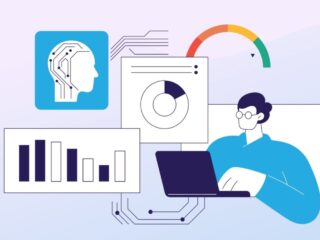
The world around us is changing rapidly. This holds true for the world as we perceive it as private citizens. And it holds true as an employee-when viewed from within the various businesses in which people work. The advent of ChatGPT has been a clear turning point for many in this regard, because it can do things that not so long ago most thought only humans would be able to do.
ChatGPT is merely one example of a development that has profoundly changed the world around us. In fact, there have been many: any developments that have changed the world, and indeed the business world as well. Another example of an important world-changing development is the advent of data as one of the most valuable commodities in the world. And the rise of such professions as data engineers and data scientists. Other notable developments of world-changing developments include the transition of the banking sector to something that increasingly resembles an IT corporation more than anything else. And other notable examples include the rise of crypto currencies and concepts such as blockchain.
Accounts Receivable Management Services
This notion that the only thing that is constant is change seems to hold true for the field of accounts receivable management services as much as many other sectors and industries. The core purpose of this field is that it helps companies improve their cash flow and their working capital by avoiding that unpaid invoices turn into bad debt. Other important, and timeless, themes that seem to play an important role in this sector include: the maintenance of strong customer relationships; and the avoidance of burning bridges where this can be avoided. But also here, in the accounts receivable management services sector, traditional methods are giving way to new, technology-driven practices. These practices promise organizations that they get to enjoy greater efficiency. They improve transparency, which also benefits you as a customer. And they improve the strategic insight for organisations.
Relevant examples here include AI-based payment prediction models. Soon AI-systems will be able to predict when and if you will be paying. There are also systems, like Atradius’ Credit-IQ, that automate the sending out invoice reminders.
Automation And Ai: The New Driving Forces In Accounts Receivable Management Services
Where AI is clearly the new kid on the block, the term automation has been in play in business for decades. The transformative and even disruptive power of AI is self-evident. The same continues to hold true for automation, even though this has been a force of significance for decades. Before the advent of computers, everything from sending out invoices, to payment reminders all the way up to legal proceedings, were only done by humans who could only rely on a paper and a pen. To a large degree, much of this has already been automated. There is a large number of software solutions that can automatically send out payment reminders for you, for example, including Invoiced’s, BILL and Atradius’ Credit-IQ.
Many other things have also been automated. And this has moved far beyond the Excel spreadsheet that seemed revolutionary in the last couple of decades of the previous century. These software products help free up finance teams’ time so they can focus on higher-value activities. And these solutions often reduce the risk of errors being made, which is inherent to letting humans do something. This greater accuracy accelerates the entire payment cycle. Therefore, these software solutions help businesses secure revenue faster. So automation is already playing an important role in accounts receivable management services.
Ai And Automation
AI can and does do so much more than merely automation. Intelligent systems will soon even be able to predict customer payment behaviours. They can identify red flag or high risk accounts early on. This enables a proactive intervention before cash flow problems arise. This data-driven approach allows companies to tailor collection efforts. They can for example dedicate extra time and energy to the high risk accounts. The improved forecasting accuracy also helps prevent sales to customers that are deemed carry too high of a risk. And ultimately reduce days sales outstanding (DSO). For finance professionals, these capabilities mark a shift from reactive collections to a more strategic function that supports overall business health.
Real-Time Analytics: The Cornerstone Of Modern Accounts Receivable Management Services
Real-time analytics has become an important component of modern accounts receivable management services. Acces to real time accurate dashboards gives decision makers the insight needed to make relevant decisions. Consequently, this helps companies to make quick adjustments to for example credit policies. Or they can change collection strategies based on indications from the data analytics, where they had to rely on guesswork in the past.
Accounts Receivable Management Service Innovations
There are many small accounts receivable management service agencies in the world. Some of them even consist of just one person. Then there just a few big companies in this field. Out of the big accounts receivable management service companies, Atradius Collections is one of the most renowned ones – one of the ones that have been around the longest. A look at how they do things, gives us an idea of how these IT-driven innovations will take form in practice. Atradius Collections has been automating things on the workfloor for decades. And throughout this, it has delivered significant results for the company.
Now the news kids on the block are AI and data science. Data science has brought about to the ability to deliver efficient and transparent receivables management. Atradius shows that this is something that can be implemented on a global scale. And it doesn’t just benefits themselves and their customers, but also you as a debtor.
A hallmark in their digital service offering is Atradius Agora. Atradius Agora is an e-commerce collections platform. The platform enables businesses to submit debt collection cases – and to subsequently monitor them on the platform. This helps streamline the traditional manual process. This dovetails neatly with a few industry-wide trends. Trends such as automation and real-time transparency. For clients of the company this means the collections process becomes more accessible and responsive.
Another important product that Atradius developed is called Atrium Tools. Atrium Tools serves as a digital dashboard that helps centralize the accounts receivable management insurances. The tool boasts insurance policies; in doing so it makes it clear how digital integration improves risk management. And besides mitigating risks, it also helps improve efficiency. In that regard it’s a double whammy.
A third product by Atradius Collections that is important to mention is Collect@Net. Collect@Net facilitates automated collections workflows. It includes features ranging from reminder scheduling to dispute handling. The tool helps reduce the workload for its users. And one of the outcomes, which are quite important to Atradius’ clients, is that it helps improve the recovery rate of its arrears.
Atradius hasn’t just developed software products of its own. The company also collaboraties with Oracle as it seeks to work toward its imagined IT future. The company has used Oracle Sales Cloud to integrate credit management with sales and customer data. Many industry analysts believe that such a drive toward connected systems is the future of accounts receivable. This integration enables more accurate customer segmentation, so that for each debtor the company can make an accurate prediction as to what they can expect. The collaboration with Oracle also helps bring about predictive analytics.
The growing adoption of customer segmentation techniques further personalises follow-ups and improves collection success rates by aligning actions with individual payment histories and risk profiles.
Could you add the alt text ‘accounts receivable management services’ to the images?














